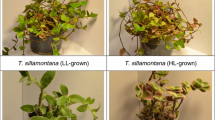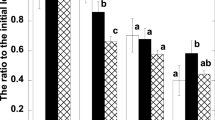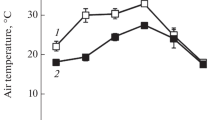Abstract
The obligate shade plant, Tradescantia albiflora Kunth grown at 50 μmol photons · m−2 s−1 and Pisum sativum L. acclimated to two photon fluence rates, 50 and 300 μmol · m−2 · s−1, were exposed to photoinhibitory light conditions of 1700 μmol · m−2 · s−1 for 4 h at 22° C. Photosynthesis was assayed by measurement of CO2-saturated O2 evolution, and photosystem II (PSII) was assayed using modulated chlorophyll fluorescence and flash-yield determinations of functional reaction centres. Tradescantia was most sensitive to photoinhibition, while pea grown at 300 μmol · m−2 · s−1 was most resistant, with pea grown at 50 μmol · m−2 · s−1 showing an intermediate sensitivity. A very good correlation was found between the decrease of functional PSII reaction centres and both the inhibition of photosynthesis and PSII photochemistry. Photoinhibition caused a decline in the maximum quantum yield for PSII electron transport as determined by the product of photochemical quenching (qp) and the yield of open PSII reaction centres as given by the steady-state fluorescence ratio, F′vF′m, according to Genty et al. (1989, Biochim. Biophys. Acta 990, 81–92). The decrease in the quantum yield for PSII electron transport was fully accounted for by a decrease in F′vF′m, since qp at a given photon fluence rate was similar for photoinhibited and noninhibited plants. Under lightsaturating conditions, the quantum yield of PSII electron transport was similar in photoinhibited and noninhibited plants. The data give support for the view that photoinhibition of the reaction centres of PSII represents a stable, long-term, down-regulation of photochemistry, which occurs in plants under sustained high-light conditions, and replaces part of the regulation usually exerted by the transthylakoid ΔpH gradient. Furthermore, by investigating the susceptibility of differently lightacclimated sun and shade species to photoinhibition in relation to qp, i.e. the fraction of open-to-closed PSII reaction centres, we also show that irrespective of light acclimation, plants become susceptible to photoinhibition when the majority of their PSII reaction centres are still open (i.e. primary quinone acceptor oxidized). Photoinhibition appears to be an unavoidable consequence of PSII function when light causes sustained closure of more than 40% of PSII reaction centres.
Similar content being viewed by others
Abbreviations
- Fo and F′o :
-
minimal fluorescence when all PSII reaction centres are open in darkness and steady-state light, respectively
- Fm and F′m :
-
maximal fluorescence when all PSII reaction centres are closed in darkand light-acclimated leaves, respectively
- F′v :
-
variable fluorescence
- (F′m-F′o):
-
under steady-state light con-ditions
- Fs :
-
steady-state fluorescence in light
- QA :
-
the primary,stable quinone acceptor of PSII
- qNe :
-
non-photochemical quench-ing of fluorescence due to high energy state
- (ΔpH); qNi :
-
non-photochemical quenching of fluorescence due to photoinhibition
- qp :
-
photochemical quenching of fluorescence
References
Adamson, H.Y., Chow, W.S., Anderson, J.M., Vesk, M., Sutherland, M. (1991) Photosynthetic acclimation of Tradescantia albiflora to growth irradiance: morphological, ultrastructural and growth responses. Physiol. Plant. 82, 353–359
Anderson, J.M., Osmond, C.B. (1987) Shade-sun responses: compromises between acclimation and photoinhibition. In: Topics in photosynthesis. Photoinhibition, vol. 9, pp. 1–38, Kyle, D.J., Osmond, C.B., Arntzen, C.J., eds. Elsevier, Amsterdam
Ball, C.M., Hodges, V.S., Laughlin, G.P. (1991) Cold-induced photoinhibition limits regeneration of snow gum at tree line. Funct. Ecol., in press
Bilger, W., Schreiber, U. (1986) Energy-dependent quenching of dark-level chlorophyll fluorescence in intact leaves. Photosynth. Res. 10, 303–308
Björkman, O. (1987) High-irradiance stress in higher plants and interaction with other stress factors. In: Progress in photosynthesis research, vol. IV, pp. 11–18, Biggens, J., ed. Martinus Nijhoff Publ., Dordrecht, The Netherlands
Butler, W.L. (1978) Energy distribution of the photochemical apparatus of photosynthesis. Annu. Rev. Plant Physiol. 29, 345–378
Chow, W.S., Anderson, J.M. (1987) Photosynthetic responses of Pisum sativum to an increase in irradiance during growth. I. Photosynthetic activity. Aust. J. Plant Physiol. 14, 9–19
Chow, W.S., Hope, A.B., Anderson, J.M. (1989a) Oxygen per flash from leaf discs quantifies photosystem II. Biochim. Biophys. Acta 973, 105–108
Chow, W.S., Osmond, C.B., Huang, L.K. (1989b) Photosystem function and herbicide binding sites during photoinhibition of spinach chloroplasts in-vivo and in-vitro. Photosynth. Res. 21, 17–26
Chow, W.S., Anderson, J.M., Melis, A. (1990) The pohotosystem stoichiometry in thylakoids of some Australian shade-adapted plant species. Aust. J. Plant Physiol. 17, 665–674
Chow, W.S., Adamson, H.Y., Anderson, J.M. (1991a) Photosynthetic acclimation of Tradescantia albiflora to growth irradiance: Lack of adjustment of light-harvesting components and its consequences. Physiol. Plant. 81, 175–182
Chow, W.S., Hope, A.B., Anderson, J.M. (1991b) Further studies on quantifying photosystem II in vivo by flash-induced oxygen yield from leaf discs. Aust. J. Plant Physiol. 18, 397–410
Cleland, R.E., Melis, A. (1987) Probing the events of photoinhibition by altering electron transport activity and light-harvesting capacity in chloroplast thylakoids. Plant Cell Environ. 10, 265–276
Critchley, C. (1988) The chloroplast thylakoid membrane system is a molecular conveyor belt. Photosynth. Res. 19, 265–276
Delieu, T.D., Walker, D.A. (1983) Simultaneous measurement of oxygen evolution and chlorophyll fluorescence from leaf pieces. Plant Physiol. 73, 542–549
Demmig, B., Björkman, O. (1987) Comparison of the effect of excessive light on chlorophyll fluorescence (77K) and photon yield of O2 evolution in leaves of higher plants. Planta 171, 171–184
Demmig-Adams, B. (1990) Carotenoids and photoprotection in plants: A role for xanthophyll zeaxanthin. Biochim. Biophys. Acta 1020, 1–24
Foyer, C., Furbank, R., Harbinson, J., Horton, P. (1990) The mechanisms contributing to photosynthetic control of electron transport by carbon assimilation. Photosynth. Res. 25, 83–100
Genty, B., Briantais, J.-M., Baker, N.R. (1989) The relationship between the quantum yield of photosynthetic electron transport and quenching of chlorophyll fluorescence. Biochim. Biophys. Acta 990, 87–92
Genty, B., Harbinson, J., Briantais, J.-M., Baker, N.R. (1990) The relationship between non-photochemical quenching of chlorophyll fluorescence and the rate of photosystem 2 photochemistry in leaves. Photosynth. Res. 25, 249–257
Havaux, M., Strasser, R.J., Greppin, H. (1991) A theoretical and experimental analysis of the qp and qn coefficients of chlorophyll fluorescence quenching and their relation to photochemical and nonphotochemical events. Photosynth. Res. 27, 41–55
Hewitt, E.J. (1966) Sand and water culture methods used in the study of plant nutrition. 2nd edn. Commenwealth Bureau of Horticulture and Plantation Crops. East Mailing, U.K.
Horton, P. (1985) Interactions between electron transfer and carbon assimilation. In: Photosynthetic mechanisms and the environment. Topics in photosynthesis, vol. 6, pp. 135–187, Barber, J., Baker, N.R., eds., Elsevier Sci. Publ. B.V., Amsterdam
Horton, P. (1989) Interactions between electron transport and carbon assimilation: regulation of light-harvesting and photochemistry. In: Photosynthesis, pp. 393–406, Briggs, W.R., ed., Alan R. Liss, New York
Horton, P., Hague, A. (1988) Studies of the induction of chlorophyll fluorescence in isolated barley protoplasts. IV. Resolution of non-photochemical quenching. Biochim. Biophys. Acta 932, 107–115
Krause, G.H. (1988) Photoinhibition of photosynthesis. An evaluation of damaging and protective mechanisms. Physiol. Plant. 74, 566–574
Krause, G.H., Laasch, H., Weis, E. (1988) Regulation of thermal dissipation of absorbed light energy in chloroplasts indicated by energy-dependent fluorescence quenching. Plant Physiol. Biochem. 26, 445–452
Kyle, D.J. (1987) The biochemical basis for photoinhibition of photosystem II. In: Topics in photosynthesis. Photoinhibition, vol. 9, pp. 197–226, Kyle, D.J., Osmond, C.B., Arntzen, C.J., eds. Elsevier, Amsterdam
Leverenz, J.W., Falk, S., Pilström, C.-M., Samuelsson, G. (1990) The effects of photoinhibition on the photosynthetic light response curve of green plant cells (Chlamydomonas reinhardtii). Planta 182, 161–168
Long, S.P., Farage, P.K., Groome, Q., Macharia, J.M.N., Baker, N.R. (1990) Damage to photosynthesis during chilling and freezing, and its significance to the photosynthetic productivity of field crops. In: Current research in photosynthesis, vol. IV, pp. 835–842, Baltscheffsky, M., ed. Kluwer Acad. Publ., Dordrecht, The Netherlands
Lundmark, T., Hällgren, J.-E., Hede'n, J. (1988) Recovery from winter depression of photosynthesis in pine and spruce. Trees 2, 110–114
Markgraf, T., Berry, J. (1990) Measurment of photochemical and non-photochemical quenching: correction of turnover of PS2 during steady-state photosynthesis: In: Current research in photosynthesis, vol. IV, pp. 279–282, Baltscheffsky, M., ed. Kluwer Acad. Publ., Dordrecht, The Netherlands
Neale, P.J. (1987) Algal photoinhibition and photosynthesis in the aquatic environment. In: Topics in photosynthesis. Photoinhibition, vol. 9, pp. 39–65, Kyle, D.J., Osmond, C.B., Arntzen, C.J., eds. Elsevier, Amsterdam
Ogren, E. (1988) Photoinhibition of photosynthesis in willow leaves under field conditions. Planta 175, 229–236
Ögren, E. (1991) Prediction of photoinhibition of photosynthesis from measurements of fluorescence quenching components. Planta 184, 538–544
Ögren, E., Öquist, G. (1984) Photoinhibition of photosynthesis in Lemna gibba as induced by the interaction between light and temperature. III. Chlorophyll fluorescence at 77K. Physiol. Plant. 62, 193–200
Öquist, G., Malmberg, G. (1989) Light and temperature dependent inhibition of photosynthesis in frost-hardened and un-hardened seedlings of pine. Photosynth. Res. 20, 261–277
Öquist, G., Greer, D.H., Ögren, E. (1987) Light stress at low temperature. In: Topics in photosynthesis. Photoinhibition, vol. 9, pp. 67–87, Kyle, D.J., Osmond, C.B., Arntzen, C.J., eds. Elsevier, Amsterdam
Osmond, C.B. (1981) Photorespiration and photoinhibition. Some implications for the energetics of photosynthesis. Biochim. Biophys. Acta 639, 77–89
Ottander, C., Öquist, G. (1991) Recovery of photosynthesis in winter stressed Scots pine. Plant Cell Environ. 14, 345–349
Oxborough, K., Horton, P. (1988) A study of the regulation and function of energy-dependent quenching in pea chloroplasts. Biochim. Biophys. Acta 934, 135–143
Post, A., Adamson, E., Adamson, H. (1990) Photoinhibition and recovery of photosynthesis in antarctic bryophytes under field conditions. In: Current research in photosynthesis, vol. IV, pp. 635–638, Baltscheffsky, M., ed. Kluwer Acad. Publ., Dordrecht
Porra, R.J., Thompson, W.A., Kriedemann, P.E. (1989) Determination of accurate extrinction coefficients and simultaneous equations for assaying chlorophyll a and b with four different solvents: verification of the concentration of chlorophyll by atomic absorption spectroscopy. Biochim. Biophys. Acta 975, 384–394
Powles, S.B. (1984) Photoinhibition of photosynthesis induced by visible light. Annu. Rev. Plant Physiol. 35, 15–44
Schatz, G.H., Brock, H., Holzwarth, A.R. (1987) Picosecond kinetics of fluorescence and absorbance changes in photosystem II particles excited at low photon density. Proc. Natl. Acad. Sci. USA 84, 8414–8418
Somersalo, S., Krause, G.H. (1990) Photoinhibition at chilling temperatures and effects of freezing stress on cold-acclimated spinach leaves in the field. A fluorescence study. Physiol. Plant. 79, 617–622
Strid, Å., Chow, W.S., Anderson, J.M. (1990) Effects of supplementary ultraviolet-B radiation on photosynthesis in Pisum sativum. Biochim. Biophys. Acta 1020, 260–268
van Kooten, O., Snel, J.F.H. (1990) The use of chlorophyll fluorescence nomenclature in plant stres physiology. Photosynth. Res. 25, 147–150
Walters, R.G., Horton, P. (1991) Resolution of components of non-photochemical chlorophyll fluorescence quenching in barley leaves. Photosynth. Res. 27, 121–133
Weis, E., Berry, J.A. (1987) Quantum efficiency of photosystem II in relation to “energy”-dependent quenching of chlorophyll fluorescence. Biochim. Biophys. Acta 894, 198–208
Author information
Authors and Affiliations
Additional information
To whom correspondence should be addressed
This work was supported by the Swedish Natural Science Research Council (G.Ö.) and the award of a National Research Fellowship to J.M.A and W.S.C. We thank Dr. Paul Kriedemann, Division of Forestry and Forest Products, CSIRO, Canberra, Australia, for helpful discussions.
Rights and permissions
About this article
Cite this article
Öquist, G., Chow, W.S. & Anderson, J.M. Photoinhibition of photosynthesis represents a mechanism for the long-term regulation of photosystem II. Planta 186, 450–460 (1992). https://doi.org/10.1007/BF00195327
Accepted:
Issue Date:
DOI: https://doi.org/10.1007/BF00195327




